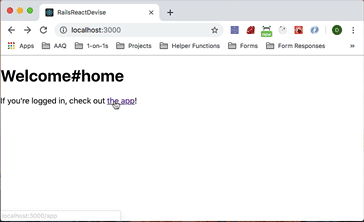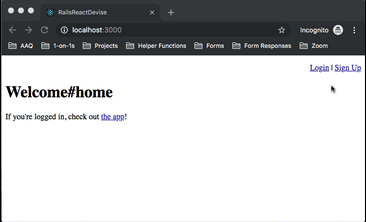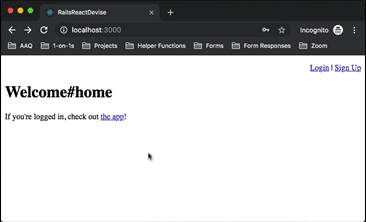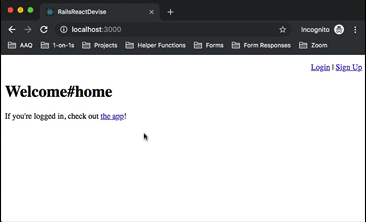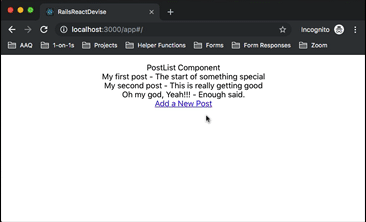This tutorial covers how to set up a Rails/React app for User authentication using Devise. It will cover the following tasks:
- Set up Webpacker
- Generate the client app with create-react-app
- Configure webpacker to read from create-react-app
- Add a home route and a route to mount the react app
- Install devise and set up user logins
- Check for authentication before rendering the react view
- Create a posts resource and some seeds
- Create a namespace for our API
- Add an index action to display the current user's posts if authenticated
- Add react router and a posts index that pulls the current user's posts
- Add the new post component and the create action in the rails controller
- Configure the new post component to pull csrf token from view and add to headers on fetch request
- Follow along with the tutorial starting with a new rails app.
- Clone it and play around with and extend it.
If you choose the second route, here's what you'll need to do to get started.
Ruby Version: 2.6.1
Rails Version: 5.2.3
Node Version: 12.1.0
Yarn Version: 1.15.2
OS: Mac OS 10.12.6
Text Editor: Visual Studio Code
git clone git@github.com:DakotaLMartinez/rails-react-devise-tutorial.gitcd rails-react-devise-tutorialyarn installrails db:migrate- (optional)
rails db:seed cd clientyarn installcd ..rails s- (in new terminal)
./bin/webpack-dev-server
You should now be able to navigate the site at localhost:3000, log in/log out/sign up and view the react app with the working Post index and Post New routes protected behind a login.
If you're following along with this tutorial in your own repo, then when you finish one of the steps, it's a good idea to make a commit, that way you can see in your version control which files are being added/modified in each step. (In VS Code, I see this in the source control view within the left hand menu bar.)
We'll want to add webpacker to the gemfile
gem 'webpacker'
and run bundle install. Then we'll do
rails webpacker:install
Finally, we'll want some of the configuration we get from installing webpacker for react, so let's do
rails webpacker:install:react
We'll keep all of the changes except for the hello_react component.
Now we'll want to generate the client app
create-react-app client
After this, make sure to add this to your .gitignore file at the root so the repo doesn't have all your node_modules in client:
# .gitignore
/client/node_modules
We'll also want to remove all references to serviceworker in index.js so it looks like this:
import React from 'react';
import ReactDOM from 'react-dom';
import './index.css';
import App from './App';
ReactDOM.render(<App />, document.getElementById('root'));
To get webpacker working with create-react-app, you'll want to change the first couple of lines of the default configuration in config/webpacker.yml from:
default: &default
source_path: app/javascript
source_entry_path: packs
to:
default: &default
source_path: client
source_entry_path: src
We'll generate a welcome controller with a couple of actions to handle a home page and also our react app.
rails g controller welcome home app --no-assets --no-helper
We'll set up the routes like this:
Rails.application.routes.draw do
get 'welcome/home'
get '/app', to: 'welcome#app', as: 'app'
# For details on the DSL available within this file, see http://guides.rubyonrails.org/routing.html
root 'welcome#home'
end
Then we'll add a link from the home view to the app view.
# app/views/welcome/home.html.erb
<h1>Welcome#home</h1>
<p>If you're logged in, check out <%= link_to "the app", app_path %>!</p>
Finally, we'll add the code we need to mount the react app in the app view:
# app/views/welcome/app.html.erb
<div id="root"></div>
<%= javascript_pack_tag 'index' %>
Now, let's check it out in the browser, if you click the link you should see create-react-app's landing page. Note: We'll get much better performance here if we're running the webpack dev server, which you can do by running
./bin/webpack-dev-server
in a spare terminal. This is what you should see at that point:
First, let's add devise to the gemfile
gem 'devise'
and the run bundle install
Next we'll run the devise installer:
rails g devise:install
Then, following along with the 4 printed instructions we get after it runs, we'll add default_url_options for action mailer to the development environment file.
# config/environments/development.rb
config.action_mailer.default_url_options = { host: 'localhost', port: 3000 }
I usually puts this at around line 38 (right below the rest of the action_mailer config at the time of this writing).
Next, let's add some flash messages above the yield tag in our application layout:
# app/views/layouts/application.html.erb
<p class="notice"><%= notice %></p>
<p class="alert"><%= alert %></p>
Note, I skipped steps 2 and 4 because in our case we've already got a root route, and we're not going to do any customization of the default devise views. If you want to customize the login and signup forms, feel free to run
rails g devise:views
At this point, we'll want to actually create our users:
rails g devise User
Devise has a bunch of features we can turn on and off, for now I'm going to stick with the defaults. To add our table we'll run
rails db:migrate
Before we hop back into the browser, let's add some simple navigation to our home view so we log in and signup/logout of our little app. (Note, we're adding this in the home view and not the layout because our react app will have its own navigation)
# app/views/welcome/home.html.erb
<nav style="text-align: right">
<% if user_signed_in? %>
<%= link_to('Logout', destroy_user_session_path, method: :delete) %>
<% else %>
<%= link_to('Login', new_user_session_path) %> |
<%= link_to('Sign Up', new_user_registration_path) %>
<% end %>
</nav>
<h1>Welcome#home</h1>
<p>If you're logged in, check out <%= link_to "the app", app_path %>!</p>
Now we can head back to the browser and try creating a new account.
NOTE: you'll need to restart your rails server if you had it running while setting up devise
Now that we have users, we can work on restricting the app to only logged in users.
Now that we've got authentication up and running, let's protect our app so only logged in users can view it. The quickest way to do this is to add a redirect to the controller action that will render our react app unless a user is signed in.
class WelcomeController < ApplicationController
before_action :authenticate_user!, only: [:app]
def home
end
def app
end
end
Now if we try to click on the link to the app page in the browser, we get redirected to the login screen. After logging in, it sends us to the app.
Next, let's create a posts resource so we can set up a couple of AJAX requests from our react front end to our rails API.
rails g resource post title content:text user:references --no-assets --no-helper
then we can run
rails db:migrate
to update our database with the posts table.
We'll also want to make sure that we update the user model so it has many posts:
# app/models/user.rb
class User < ApplicationRecord
# Include default devise modules. Others available are:
# :confirmable, :lockable, :timeoutable, :trackable and :omniauthable
devise :database_authenticatable, :registerable,
:recoverable, :rememberable, :validatable
has_many :posts
end
Finally, let's add some seeds so we've got some posts to work with.
# db/seeds.rb
user = User.first || User.create(email: 'test@test.com', password: 'password', password_confirmation: 'password')
posts = [
{
title: 'My first post',
content: 'The start of something special'
},
{
title: 'My second post',
content: 'This is really getting good'
},
{
title: 'Oh my god, Yeah!!!',
content: 'Enough said.'
}
]
posts.each do |post_hash|
user.posts.create(post_hash)
end
Then we can run those with rails db:seed
One thing we probably want to do at this point as well is to create a namespace for our api and make sure that the PostsController falls within it. This is a little extra work now and has the potential to save us large headaches down the road. For more info about why this is a good idea to do now, check out this article on API versioning.
Practically, a few things will need to change, first the routes will be namespaced, next the controller directory structure will change, and finally the way we define the controller class will be slightly different as well.
First, let's look at the routes:
# config/routes.rb
# ..
namespace :api do
namespace :v1 do
resources :posts
end
end
Now the directory structure for the controllers:
app/controllers
├── api
│ └── v1
│ └── posts_controller.rb
├── concerns
├── application_controller.rb
└── welcome_controller.rb
And then update the controller to be defined under the namespaced modules.
module Api
module V1
class PostsController < ApplicationController
end
end
end
Now if we run rails routes we can see what that does for us
Prefix Verb URI Pattern Controller#Action
api_v1_posts GET /api/v1/posts(.:format) api/v1/posts#index
POST /api/v1/posts(.:format) api/v1/posts#create
new_api_v1_post GET /api/v1/posts/new(.:format) api/v1/posts#new
edit_api_v1_post GET /api/v1/posts/:id/edit(.:format) api/v1/posts#edit
api_v1_post GET /api/v1/posts/:id(.:format) api/v1/posts#show
PATCH /api/v1/posts/:id(.:format) api/v1/posts#update
PUT /api/v1/posts/:id(.:format) api/v1/posts#update
DELETE /api/v1/posts/:id(.:format) api/v1/posts#destroy
Now, let's create an index PostsController that returns the current user's posts if we're authenticated and renders an empty response with a 401 status code if not.
# app/controllers/api/v1/posts_controller.rb
module Api
module V1
class PostsController < ApplicationController
def index
if user_signed_in?
render json: current_user.posts
else
render json: {}, status: 401
end
end
end
end
end
After we've got this endpoint stubbed out, we'll be able to use it from our react front-end.
To start, we'll want to cd into the client directory and add in the dependencies we'll need here. (We're not using redux here yet, but we will eventually so might as well pull it in now).
cd client
yarn add react-router-dom react-redux redux
After that we'll want to create the PostList component client/src/components/PostList.jsx. This component will make a fetch request within componentDidMount and update the state of the component when the promise is fulfilled.
componentDidMount() {
fetch('/api/v1/posts')
.then(posts => posts.json())
.then(posts => {
this.setState({
posts: posts
})
})
}
Next, we'll use a renderPosts method to return the html for the posts that we'll render to the DOM.
renderPosts = () => {
return this.state.posts.map(post => {
return (
<div key={post.id}>
{post.title} - {post.content}
</div>
)
})
}
Finally, we'll render the list as well as a link to the new posts route which we'll build out in a minute. When we're done it should look something like this:
// client/src/components/PostList.jsx
import React, { Component } from 'react'
import { Link } from 'react-router-dom'
class PostList extends Component {
state = {
posts: []
}
componentDidMount() {
fetch('/api/v1/posts')
.then(posts => posts.json())
.then(posts => {
this.setState({
posts: posts
})
})
}
renderPosts = () => {
return this.state.posts.map(post => {
return (
<div key={post.id}>
{post.title} - {post.content}
</div>
)
})
}
render() {
return (
<div>
PostList Component
{this.renderPosts()}
<Link to="/posts/new">Add a New Post</Link>
</div>
)
}
}
export default PostList
In order to test this out, we'll need to add react router to the client/src/App.js and configure the root route to point to our PostList component. In this case we'll also want to use the HashRouter instead of the BrowserRouter so that we'll be able to easily integrate our rails routes with our client side routing in a way that still allows for page refreshes and inbound links to work properly.
// client/src/App.js
import React from 'react';
import {
HashRouter as Router,
Route
} from 'react-router-dom';
import PostList from './components/PostList';
import './App.css';
function App() {
return (
<Router>
<div className="App">
<Route exact path="/" component={PostList} />
</div>
</Router>
);
}
export default App;
Now that we've got these changes into our react code, let's make sure that we've still got ./bin/webpack-dev-server running and check out our app in the browser!
Notice that the url when the app is loaded is now localhost:3000/app#/. All of the react routes are mounted after the # so we'll be able refresh the page at any of our react routes and the rails router will render our SPA with the react router picking up the client side routing after the #.
Now we want to allow users to create new posts. We've already got react router set up, so we'll need to add the NewPost component and then have it post to api/v1/posts for which we'll build a create action in our PostsController.
Let's start by building out the controller layer. We'll need to define our strong parameters to whitelist the :title and :content attributes.
# app/controllers/api/v1/posts_controller.rb
# ...
def post_params
params.require(:post).permit(:title, :content)
end
Next, we'll again check if the user is authenticated before creating the post and returning it in json format.
# app/controllers/api/v1/posts_controller.rb
# ...
def create
if user_signed_in?
if post = current_user.posts.create(post_params)
render json: post, status: :created
else
render json: post.errors, status: 400
end
else
render json: {}, status: 401
end
end
For good measure, let's actually create a reason that the creation could fail by adding presence validations for title and content to our Post model:
# app/models/post.rb
class Post < ApplicationRecord
belongs_to :user
validates :title, :content, presence: true
end
Next, we'll focus back on the front end. First we'll create a NewPost component that will have title and content fields whose values are stored in state. We'll also add a handleChange method that will turn the inputs into controlled inputs.
# client/components/NewPost.jsx
import React, { Component } from 'react';
class NewPost extends Component {
state = {
title: '',
content: ''
}
handleChange = e => {
let newValue = e.target.value;
let key = e.target.name;
this.setState({
[key]: newValue
});
}
render() {
return (
<form>
<p>
<label htmlFor="title">Title: </label>
<input type="text" name="title" onChange={this.handleChange} />
</p>
<p>
<label htmlFor="content">Content: </label>
<textarea name="content" id="" cols="30" rows="10" onChange={this.handleChange}></textarea>
</p>
<input type="submit" value="Create Post" />
</form>
)
}
}
export default NewPost
Finally, we'll need to add an event handler to handle the form submission. To do this we've got to do a couple of things to make this work. First, we'll prevent the default behavior on submission to stop a page refresh, next we'll also have to accomodate the cross site request forgery (CSRF) security measures that rails ships with. If we just send the fetch request without including a CSRF token created by the rails backend, Rails will raise an exception. To grab this token, we'll need to read it from the meta tags in the dom
let token = document.querySelector('meta[name="csrf-token"]').content;
After that, we'll include the token in the headers of the fetch request. We'll then parse the response as JSON and use this.props.history.push from react-router to send the user back to the PostList comopnent home view.
// client/src/components/NewPost.jsx
// ...
handleSubmit = (e) => {
e.preventDefault();
let data = {post: this.state};
let token = document.querySelector('meta[name="csrf-token"]').content;
fetch('/api/v1/posts', {
method: 'POST',
headers: {
"Content-Type": "application/json",
'X-Requested-With': 'XMLHttpRequest',
'X-CSRF-Token': token
},
redirect: "error",
body: JSON.stringify(data)
})
.then(resp => {
resp.json()
})
.then(post => {
this.props.history.push('/');
});
}
And finally, we'd add the submit event handler to the rendered form:
// client/src/components/NewPost.jsx
// ...
render() {
return (
<form onSubmit={this.handleSubmit.bind(this)}>
<p>
<label htmlFor="title">Title: </label>
<input type="text" name="title" onChange={this.handleChange} />
</p>
<p>
<label htmlFor="content">Content: </label>
<textarea name="content" id="" cols="30" rows="10" onChange={this.handleChange}></textarea>
</p>
<input type="submit" value="Create Post" />
</form>
)
}
Finally, so that we can actually get to the form, we need to hook this component up to our React router in App.js.
We'll need to import it
import NewPost from './components/NewPost';
and then add the route:
<Route exact path="/posts/new" component={NewPost} />
When we're done it should look like this:
// client/src/App.js
import React from 'react';
import {
HashRouter as Router,
Route
} from 'react-router-dom';
import PostList from './components/PostList';
import NewPost from './components/NewPost';
import './App.css';
function App() {
return (
<Router>
<div className="App">
<Route exact path="/" component={PostList} />
<Route exact path="/posts/new" component={NewPost} />
</div>
</Router>
);
}
export default App;
Now we're ready to try this out! Let's fire up our rails server and our webpack dev server if they're not already running and click through the form.
Great job getting through this tutorial! Hopefully this gives you an idea of how you could create a react app that takes advantage of user accounts using session cookies. Before I leave you here, I just wanted to discuss some potential trade offs with this approach and alternatives you might also consider.
Using cookie based authentication is fine if you're planning on only interacting with this API from your current react app within Rails, and not say from a mobile application or another web application. The reason for this is that cookies are domain specific, so if you need to enable access to your API from other domains, you'll want to take another approach like JWT or OAuth2 for authentication.
